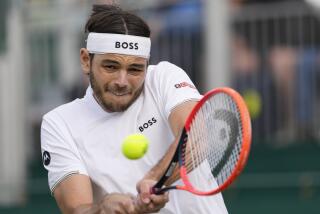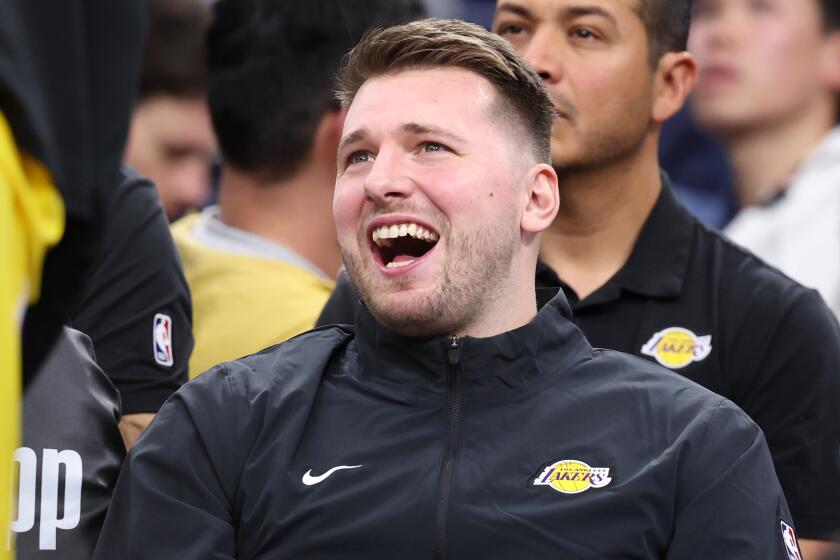NOT THE RETIRING SORT : After 30 Years Practicing Law, Tom Brown Got Back to Competitive Tennis
- Share via
Tom Brown pushed his plate back from the edge of the table inside the players’ lounge at the Lindborg Racquet Club in Huntington Beach and shook his head.
“Back in the good old days, before anyone got paid for playing tennis, getting a free meal was a big thing,” Brown, 65, said Tuesday. “If you were a top player, you got your name on a list that got you a free lunch.
“If you lost, your name got taken off the list. So when I would lose, I would rush to the dining room before going to the locker room to change. I wanted to eat before they found out I’d lost. The way money was then, getting a free meal often was the difference between eating and going hungry.”
It seems absurd these days to think that Brown, who won the Wimbledon doubles championship in 1946 and finished runner-up in its singles championship in ‘47, had to worry in those years about such basics. But the game was different then. It was still a quarter-century away from the easy money of the open era.
Brown was born too early to benefit from the recent emergence of professional tennis. But he’s enjoying new life on the amateur senior circuit.
The No. 1-ranked 65-and-over player in the United States, Brown is leading the five-man U.S. team in the Britannia Cup tournament this week at Lindborg. The tournament is one of three Davis Cup-styled international team events. Along with the Austria Cup (55-and-over) and the Dubler Cup (45-and-over), the Britannia Cup (65-and-over) features teams of the world’s best seniors. Play continues Thursday, with the United States meeting Australia. In the Britannia’s nine-year existence, the United States has never lost.
“There’s some national pride involved,” Brown said. “It’s prestigious to be picked for the squad, too. It says you’re a top player.”
Brown always has been. He picked up the game as a teen-ager in San Francisco, and by the outbreak of World War II had emerged as one of the world’s best. After 2 1/2 years in the Army, he resumed his tennis career, and rose to No. 4 in the world.
In 1946, at 23, he teamed with the legendary Jack Kramer to win the Wimbledon doubles title. A year later, he advanced to the singles final before losing to Kramer in straight sets.
“It was the shortest Wimbledon singles final of all time up to that point,” Brown said. “Kramer was such a great player. I just had a bad day.”
Two years later, Brown retired to pursue a career in law. He received his law degree from California in 1949 and opened his own firm in San Francisco. But he never lost his passion for tennis.
“I’d play on the weekends and in some tournaments now and then,” Brown said. “Nothing big. I didn’t have time, what with running a business and raising a family. I never imagined I would be a serious competitive player again.”
But then came retirement. After 30 years of developing a successful law practice and raising four children, Brown was ready for a new challenge. He entered a few 55-and-over tournaments two years ago, and surprised even himself.
“I’m playing about 15 events a year, doing a lot of traveling all over the world,” Brown said.
The years have been kind to Brown. He still has quite a backhand, teammates say, though his serve isn’t what it used to be.
“I guess the serve is the first thing to go,” Brown said. “And I’m not as mobile as I used to be. I can’t keep up with the young kids. My eyes aren’t what they used to be, either. Obviously, my muscle strength can’t compare to a young person’s.
“But my reflexes are still good. People think your reflexes leave you, but they don’t. My style’s still pretty much the same: I’m heavy off the ground.”
Last month, Brown won the 65-and-over division at the European Seniors Championship in West Germany. And he shows no signs of relenting.
“I heard about this 85-and-over event in New York a few months ago,” he said. “There were more than a dozen entries . . . and everyone finished. I guess you could say I’ve got something to look forward to.”
When Brown was one of the world’s top players, the thinking was that when a player reached 30 his career was over.
“I remember after I quit playing competitively, I would go out and play in some amateur tournaments on the weekends and people thought I was crazy,” Brown said. “They thought it would be a deterrent to good health. Of course, all that thinking has changed now.”
And Brown is the better for it.
“I kept right on playing, and I’m still in great shape,” he said. “Back then, I never thought I’d be playing tennis on any kind of competitive level at this age. But here I am, doing pretty well at 65. I hope to play as long as I can.”
More to Read
Go beyond the scoreboard
Get the latest on L.A.'s teams in the daily Sports Report newsletter.
You may occasionally receive promotional content from the Los Angeles Times.










